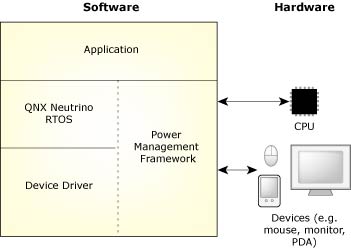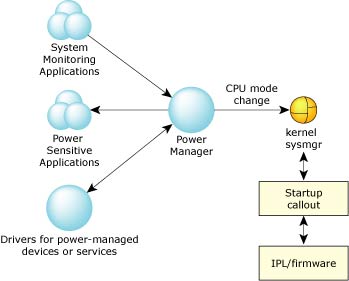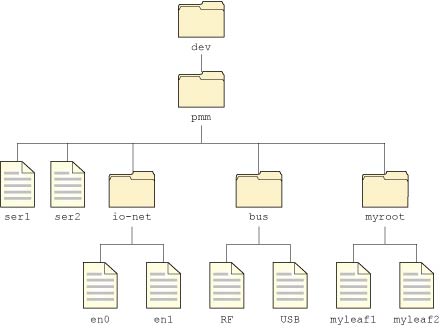![[Previous]](prev.gif) |
![[Contents]](contents.gif) |
![[Next]](next.gif) |
![[Previous]](prev.gif) |
![[Contents]](contents.gif) |
![[Next]](next.gif) |
 |
This version of this document is no longer maintained. For the latest documentation, see http://www.qnx.com/developers/docs. |
This chapter contains the following topics:
This chapter describes the power management framework along with two different approaches for power management support. It also provides the major components of the power management architecture. In addition, it includes a discussion on power managed entities, power modes (states), and power managed objects.
The power management framework is included as part of the QNX Neutrino RTOS. It is based on the principle of providing mechanisms -- not policies -- to control and manage power. You use these mechanisms to implement your own power management policy, i.e. what determines how to save energy or when to go to a low-power state. The framework consists of the following:

Power management framework as part of QNX Neutrino RTOS.
In order to accommodate the above framework, the power management architecture can be broken into two parts:
The major components of the power management architecture are:
 |
Basic device and CPU power management can be implemented without requiring the power manager. |

Components of the power management architecture
These are the device drivers that manage the power consumption of the hardware devices they control. These device drivers have the most intimate knowledge of the device's usage pattern and power consumption characteristics. Therefore, they determine when the devices should change power states or which states are appropriate for current usage.
Power managed services are some arbitrary software components whose behavior can be modeled via power modes.
These are applications whose behavior depends on the power mode of the system specific drivers or software subsystems.
These are applications that monitor specific system parameters that are relevant to the system-wide power management policy. For example, you may consider monitoring battery levels or other data that may require changing the system power mode.
Low-level power management architecture provides a straight forward way of controlling the power modes of the device drivers and the CPU.
At the most basic level, the framework provides a set of low-level services to:
This low-level architecture can provide a very simple form of power management, subject to the following restrictions:
Although this architecture may be suitable for some extremely simple embedded systems, a more comprehensive, system-wide power management policy would typically require much tighter integration with application-level services provided by the product. This is achieved by a higher level set of services that are based around the use of a centralized power manager, described in the next section.
You can find details about this architecture in the Low-level Power Management chapter.
The power manager architecture has two important components: the server and the client. The power manager is referred to as the server, and it implements a centralized power management policy. The power manager interacts with the clients, such as power managed devices or services to determine device power capabilities and to manipulate device power states.
The power management policy is product specific. It takes into consideration various operating modes of the product. Each mode determines the available functions of the product based on power constraints. The policy:
The power manager is implemented using a library that provides the basic mechanisms for:
You should use the server library to implement your own product-specific power manager. In essence, it is the specific power manager code that uses the server library and is built by linking product-specific initialization and policy code. The services provided by the library interact with the policy code to manage the overall system power mode state. See Implementing System Power Management Policy in this guide for details.
The power manager interacts with the clients to control the use of power for your hardware peripherals. See the Power Manager Clients chapter in this guide for details.
The Power Management Toolkit includes both a server and client library to provide a rich set of APIs and datatypes that enable two-way communication between the server and the clients. See the API Reference chapter in this guide for a list of APIs and datatypes.
Power managed entities include:
In addition, the CPU is also a power managed entity; it provides active, idle and standby operational mode. Many embedded processors allow scaling of power consumption within the CPU's active operating mode using techniques such as voltage or frequency scaling.
The power management framework defines four generic power modes that apply to power managed entities:
Different power managed entities may support further modes -- a number of different states within each of these generic power modes. For example, different Active states represent different operating modes that provide tradeoffs between performance and power consumption.
The framework allows each power managed entity to define these different entity-specific states and how they map to these modes.
Power managed objects represent the power managed entities in a hierarchical namespace. Each object within this namespace describes:
The namespace hierarchy provides a rudimentary configuration database that represents:

Power managed objects as represented in a hierarchical namespace.
![[Previous]](prev.gif) |
![[Contents]](contents.gif) |
![[Next]](next.gif) |